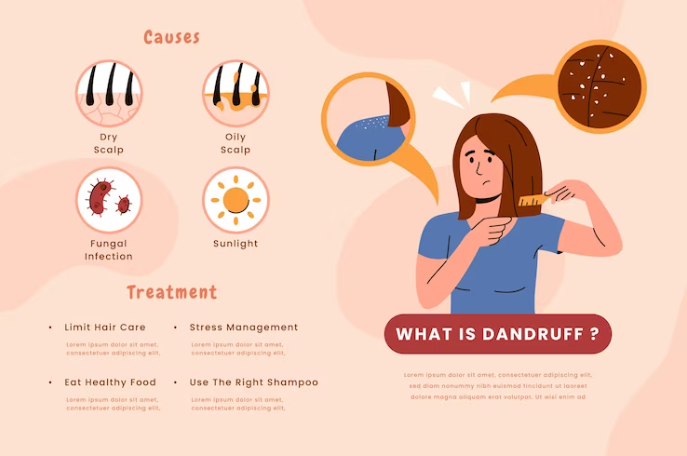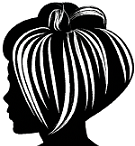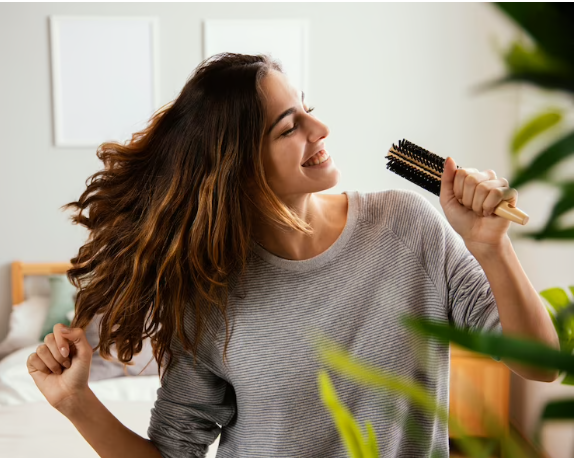hair care tips for growing long hair. Are you tired of waiting endlessly for your hair to grow longer or become thicker? While hair naturally grows at a rate of 0.5 to 1.7 centimeters per month, it might seem like a slow process when you’re eagerly anticipating longer locks.
Shedding 50 to 100 hairs a day is normal, but if you feel your hair growth is sluggish, there are simple changes you can make to your daily hair care routine to encourage faster hair
growth.
From choosing the right hairbrush to adjusting your hair drying habits and incorporating hair growth-boosting oils and foods, this guide will unveil expert secrets and home remedies for achieving faster and stronger hair growth in 2023. We help you achieve the hair of your dreams.
for more articles
How to take care of men’s long hair
Your hair-growth starter pack

A hair-growth starter pack typically includes products and tools aimed at promoting hair growth and maintaining healthy hair. Here’s a list of common items you might find in such a starter pack:
Shampoo and Conditioner:
Look for products containing ingredients like biotin, keratin, or caffeine, which can help strengthen hair and encourage growth.
- Hair Growth Serum:
These serums often contain active ingredients like minoxidil or natural extracts to stimulate hair follicles.
- Hair Growth Vitamins:
Supplements with vitamins like Biotin (Vitamin B7), Vitamin E, and Vitamin D may support hair growth.
- Scalp Massager: Hair care tips for growing long hair
Massaging your scalp can improve blood circulation and promote hair growth.
- DHT Blockers:
Products containing ingredients like saw palmetto may help reduce the effects of DHT, a hormone linked to hair loss.
- Hair Oil|hair care tips for growing long hair
Some natural oils, such as castor oil or argan oil, are believed to nourish the scalp and hair follicles.
- Hair Growth Comb or Brush:
These tools can help distribute oils, stimulate the scalp, and reduce breakage.
- Silk or Satin Pillowcase:
These can reduce friction and help prevent hair breakage.
- Hair Accessories: hair care tips for growing long hair
Gentle hair ties or clips to avoid pulling and damaging hair.
- Informational Materials:
Often, starter packs include educational materials on proper hair care and lifestyle tips to support hair growth.
so, that individual results may vary, and it’s essential to consult with a healthcare professional or dermatologist for personalized advice on addressing hair loss or promoting hair growth. Additionally, consider your specific hair type and any underlying causes of hair loss when choosing products for your hair growth regimen.
prescription hair-growth treatments
Prescription hair-growth treatments include various options:
Minoxidil:
This topical medication is available in different strengths and is applied directly to the scalp. It is commonly prescribed for both men and women to stimulate hair growth.
Finasteride:
This oral medication is typically prescribed for men to inhibit the hormone responsible for male pattern baldness. It can slow hair loss and promote regrowth.
Platelet-Rich Plasma (PRP) Therapy:
This procedure involves injecting a patient’s own blood plasma into the scalp to stimulate hair follicles.
Low-Level Laser Therapy (LLLT):
LLLT devices, like laser caps or combs, are prescribed to stimulate hair growth through low-level laser light.
Prescription shampoos and topical steroids:
These may be recommended for specific conditions causing hair loss or inflammation of the scalp.
Hair transplant surgery:
In cases of severe hair loss, surgical options like hair transplantation may be considered.
It’s essential to consult a healthcare professional for an accurate diagnosis and personalized treatment plan. These treatments may have side effects and varying effectiveness depending on the individual and the underlying cause of hair loss.
for more articles
how-to-take-care-curly-frizzy-hair
Try microneedling with PRP for hair growth
Microneedling with Platelet-Rich Plasma (PRP) is a promising treatment for hair growth, particularly in cases of androgenetic alopecia (standard male and female pattern baldness). PRP contains growth factors that can stimulate hair follicles, and when combined with microneedling, it enhances the effectiveness of the treatment.
Here’s how it works:
Microneedling: This involves using a device with tiny needles to create micro-injuries in the scalp. These micro-injuries stimulate the body’s natural wound-healing response, increasing blood circulation and collagen production in the scalp.
PRP: Platelet-rich plasma is prepared from a small sample of your own blood. It contains concentrated growth factors that support tissue regeneration. When applied to the scalp, it can promote hair follicle health and stimulate hair growth.
Studies have shown positive results in terms of increased hair thickness, density, and overall improvement in hair quality when using microneedling with PRP for hair loss. However, individual results may vary, and multiple sessions are typically required for optimal outcomes.
Before considering this treatment, consult with a qualified medical professional to determine if it’s suitable for your specific hair loss condition. They can provide personalized advice and a treatment plan tailored to your needs.
Try scalp microneedling at home: hair care tips for growing long hair.
Scalp microneedling is a technique that involves using a dermaroller or dermapen with tiny needles to create micro-injuries on the scalp. It is believed to promote hair growth by stimulating blood flow and collagen production. However, it’s essential to approach this procedure with caution if you plan to do it at home.
Here’s what you need to know:
- Expert Warnings:
Many experts advise against DIY microneedling for hair loss. It’s a procedure that should ideally be performed by a trained professional to minimize the risk of complications and ensure effectiveness.
- Safety First: Hair care tips for growing long hair
If you still want to try it at home, make sure to use a clean and sterilized dermaroller or dermapen. Follow proper hygiene practices to reduce the risk of infection.
- Consult a Dermatologist: hair care tips for growing long hair
Before attempting scalp microneedling, consult a dermatologist or hair loss specialist. They can assess whether it’s suitable for your specific condition and provide guidance.
- Consistency is Key:
Consistency in your microneedling routine is crucial. Results may take several months to become noticeable, so be patient.
- Use Appropriate Products:
Some microneedling kits come with serums or topical treatments designed to enhance the effects. Follow the instructions provided with your kit.
- Monitor Progress: Hair care tips for growing long hair
Keep track of your progress and watch for any adverse reactions. If you experience excessive redness, irritation, or other concerns, discontinue the treatment and seek professional advice.
In summary, while scalp microneedling has shown promise for hair growth, it’s best to consult a professional for this procedure. If you still decide to do it at home, prioritize safety, and hygiene, and consult with a specialist for guidance and monitoring.
Meet your scalp-care routine
Taking care of your scalp is essential for maintaining healthy hair. Here’s a comprehensive scalp-care routine to help you achieve a healthy and vibrant scalp:
1. Cleansing
Regularly cleanse your scalp with a gentle shampoo. This removes dirt, excess oil, and product buildup. Use lukewarm water and massage the shampoo into your scalp, then rinse thoroughly.
2. Exfoliation
Consider using a scalp exfoliant or scrub to remove dead skin cells and improve circulation. This step can promote hair growth and prevent flakes. Be gentle to avoid irritation.
3. Moisturizing
Apply a scalp-friendly moisturizer to keep your scalp hydrated and nourished. Look for products with ingredients like aloe vera or jojoba oil to soothe and moisturize.
4. Massage
Regularly massage your scalp to stimulate blood flow and promote hair growth. Use your fingertips and apply gentle pressure while moving in circular motions. This can also help relax you.
5. Protection
Protect your scalp from sun exposure and harsh weather conditions. Wear a hat or use products with SPF when necessary. This prevents damage to your scalp and hair follicles.
At any time you should see a dermatologist about hair growth
If you’re concerned about the health of your hair or experiencing hair loss, you should consult a dermatologist. Dermatologists are experts in all things skin, hair, and nails, and they can help you in a variety of circumstances regarding your hair:
Sudden or Excessive Hair Loss: If you’ve observed a lot of hair falling out or your hair has substantially thinned, visit a dermatologist immediately. They are capable of determining the underlying problem and recommending relevant therapies or solutions.
Pattern Hair Loss: Whether you suspect you have female or male pattern hair loss, dermatologists can diagnose the problem and provide treatment choices. This could include topical medicines or even surgical procedures such as hair transplants.
Persistent Scalp Conditions: Dermatologists can help with scalp conditions such as dandruff, psoriasis, or dermatitis, which can have an impact on hair health. Treatment of these disorders can increase hair growth.
Overall Hair Health: Even if you don’t have specific concerns, seeing a dermatologist on a regular basis can help you maintain the health of your hair and receive advice on hair care routines and products adapted to your needs.
To summarize, whenever you encounter serious hair issues, from sudden hair loss to persistent scalp diseases, you should contact a dermatologist to guarantee appropriate diagnosis and efficient treatment.
Hair Care 101: Tips and Tricks For Better Hair

Maintaining healthy and beautiful hair requires a combination of proper care and lifestyle choices. Here are some tips and tricks for better hair:
- Regularly Trim Your Hair:
Get regular trims to prevent split ends and maintain hair health.
- Use the Right Hair Care Products:
Choose products suitable for your hair type and concerns. Avoid excessive use of heat-styling tools.
- Healthy Diet:
To promote hair growth, consume a balanced diet rich in vitamins and minerals, particularly biotin and keratin.
- Scalp Care:
Maintain a clean and healthy scalp. Consider using a scalp massage or exfoliation routine.
- Avoid Overwashing:
Overwashing can strip natural oils from your hair. Aim to wash it 2-3 times a week or as needed.
- Protect Your Hair:
Use hair accessories like silk scrunchies to prevent breakage and damage.
- Stay Hydrated and Manage Stress:
Drinking enough water and managing stress can positively impact hair health.
- Avoid Tight Hairstyles:
Tight hairstyles can lead to hair loss. Opt for looser styles when possible.
- Use Conditioner Wisely:
Apply conditioner to the ends of your hair to avoid weighing down the roots.
- Protect Hair from Sun and Chlorine:
Wear a hat when in the sun and rinse your hair thoroughly after swimming in chlorinated pools.
By following these tips and tricks, you can improve the health and appearance of your hair. Remember that consistency and patience are key to achieving long-lasting results.
Why trust free hair?
“Free Hair” is a website that offers useful information about hair fashion trends, hairstyles, and haircuts. Excellent information and assistance from our staff, which gathers all relevant facts to bring to you in one location.
To foster long hair growth, maintain a balanced diet, avoid excessive heat styling, trim regularly, choose suitable hair care products, and consider scalp massages.
To maintain shorter hair, trim regularly, use products that reduce growth or thickness, and opt for hairstyles aligned with your desired length.
Hair generally grows at a rate of 0.5 to 1.7 centimeters (0.2 to 0.7 inches) per month, totaling about 6 to 20 centimeters (2.4 to 7.9 inches) annually.
Encourage hair growth by maintaining a nutritious diet, minimizing heat and chemicals, considering supplements (with professional guidance), using growth-promoting products, and prioritizing scalp health. However, remember that individual growth rates vary due to genetics.

